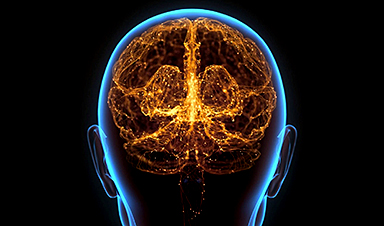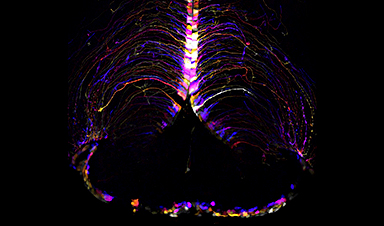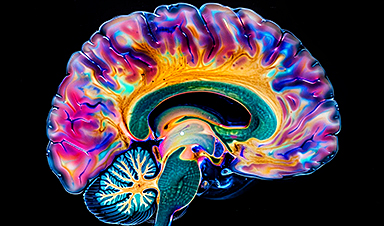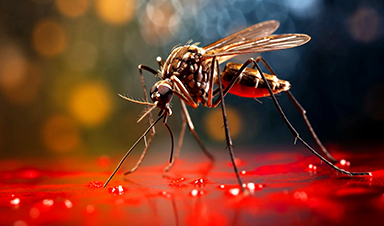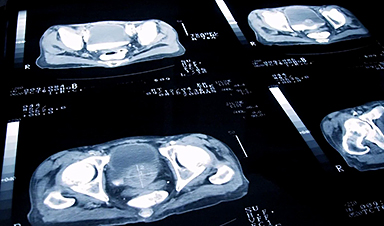Just as a tight core is a component of good physical fitness for humans, helping to stabilize our bodies, mutations that tightened the core of the SARS-CoV-2 spike protein in new variants may have increased the virus’s fitness.
“We wanted to see how the spike protein morphed structurally as it evolved from the original wild-type strain of the virus, through the alpha, delta and most recently omicron variants,” said Ganesh Anand, associate professor of chemistry and of biochemistry and molecular biology, Penn State.
“We found that the spike protein was initially more flexible at the stem region, which is where the spike protein is bundled together, but over time, mutations caused the protein to become progressively tighter and more rigid, and we think it’s now as rigid as it can get. This is important because it means that vaccines that are developed to target the current variant with these rigid spike proteins are likely to be effective for much longer than previous vaccines against the more flexible wild-type strain.”
To study how the spike protein changed with each of the new variants, the team studied the virus in vitro (in a test tube) using a technique called amide hydrogen/deuterium exchange mass spectrometry.
Anand explained that the SARS-CoV-2 spike protein is composed of three chain molecules called monomers that are bound together to form a trimer. The spike protein is made up of two subunits, an S1 and S2 subunit. The S1 subunit contains a receptor binding domain while the S2 subunit contains the stem region responsible for bundling the trimer.
“It is analogous to a tree, with the stem forming the trunk and the receptor binding domain forming the branches,” said Anand.
The team’s results, which published in the journal eLife, revealed that the spike protein stem first became more rigid with the D614G mutation, which is common to all SARS-CoV-2 variants. The stem became progressively more twisted with the emergence of new mutations in subsequent variants, and the omicron BA.1 variant showed the largest magnitude increase in stabilization relative to preceding variants.
Why would the virus benefit from a tighter core?
“We did not study the virus in patients, so we cannot determine if the changes we observed in the spike protein directly affected the newer variants such as omicron’s ability to transmit more readily; however, we can say that the changes likely made the virus more fit, which could translate to better transmission,” said Anand.
“A tighter core could likely make the virus more stable in nasal droplets and faster at binding to and entering host cells. So, for example, what initially took about 11 days to develop an infection after exposure now takes only about four days.”
Anand noted that one of the reasons the vaccines have not been able to fully neutralize the virus is because they were generated against the spike protein of the original wild-type variant.
“The latest bivalent booster—which targets newer variants—helps, but people who never got this booster aren’t receiving this more targeted protection,” he said. “Future vaccines that focus specifically on omicron are likely to be effective for longer.”
Finally, Anand said that the spike protein has now become so tightly twisted that it is unlikely to structurally change further at the stem region.
“There are limits to how much it can tighten,” he said. “I think that we can have some cautious optimism, in that we’re not going to continuously have variants emerging, at least tightening is not going to be a mechanism.”
News
False Memories Under Fire: Surprising Science Behind What We Really Recall
New research challenges the ease of implanting false memories, highlighting flaws in the influential “Lost in the Mall” study. By reexamining the data from a previous study, researchers found that many supposed false memories [...]
Born Different? Cambridge Scientists Uncover Innate Sex Differences in Brains
Cambridge researchers found that sex differences in brain structure exist from birth, with males having more white matter and females more grey matter, highlighting early neurodiversity. Research from the Autism Research Centre at the University [...]
New study shows risk factors for dementia – virus causes deposits in the brain
Research into the causes of Alzheimer's is not yet complete. Now a new study shows that head trauma can activate herpes viruses and promote the disease. Frankfurt am Main – As a neurodegenerative disease, [...]
Are Machines Truly Thinking? Modern AI Systems Have Finally Achieved Turing’s Vision
Modern AI systems have fulfilled Turing’s vision of machines that learn and converse like humans, but challenges remain. A new paper highlights concerns about energy consumption and societal inequality while calling for more robust [...]
The Surprising Link Between Smell, Sound, and Emotions
New research reveals how smell and hearing interact in the brain to drive social behavior, using mouse maternal instincts as a model. Imagine you’re at a dinner party, but you can’t smell the food [...]
Brain cells age at different rates
As our body ages, not only joints, bones and muscles wear out, but also our nervous system. Nerve cells die, are no longer fully replaced, and the brain shrinks. "Aging is the most important risk factor [...]
Long COVID Breakthrough: Spike Proteins Persist in Brain for Years
Researchers have discovered that the SARS-CoV-2 spike protein persists in the brain and skull bone marrow for years after infection, potentially leading to chronic inflammation and neurodegenerative diseases. Researchers from Helmholtz Munich and Ludwig-Maximilians-Universität (LMU) have [...]
Water-Resistant Paper Could Revolutionize Packaging and Replace Plastic
A groundbreaking study showcases the creation of sustainable hydrophobic paper, enhanced by cellulose nanofibres and peptides, presenting a biodegradable alternative to petroleum-based materials, with potential uses in packaging and biomedical devices. Researchers aimed to [...]
NIH Scientists Discover Game-Changing Antibodies Against Malaria
Novel antibodies have the potential to pave the way for the next generation of malaria interventions. Researchers at the National Institutes of Health (NIH) have identified a novel class of antibodies that target a previously unexplored region [...]
Surprising Discovery: What If Some Cancer Genes Are Actually Protecting You?
A surprising discovery reveals that a gene previously thought to accelerate esophageal cancer actually helps protect against it initially. This pivotal study could lead to better prediction and prevention strategies tailored to individual genetic [...]
The Cancer Test That Exposes What Conventional Scans Miss
Researchers at UCLA have unveiled startling findings using PSMA-PET imaging that reveal nearly half of patients diagnosed with high-risk prostate cancer might actually have metastases missed by traditional imaging methods. This revelation could profoundly affect future [...]
Pupil size in sleep reveals how memories are processed
Cornell University researchers have found that the pupil is key to understanding how, and when, the brain forms strong, long-lasting memories. By studying mice equipped with brain electrodes and tiny eye-tracking cameras, the researchers [...]
Stanford’s Vaccine Breakthrough Boosts Flu Protection Like Never Before
Stanford Medicine researchers have developed a new method for influenza vaccination that encourages a robust immune response to all four common flu subtypes, potentially increasing the vaccine’s efficacy. In laboratory tests using human tonsil [...]
Water’s Worst Nightmare: The Rise of Superhydrophobic Materials
New materials with near-perfect water repellency offer potential for self-cleaning surfaces in cars and buildings. Scientists from Karlsruhe Institute of Technology (KIT) and the Indian Institute of Technology Guwahati (IITG) have developed a surface [...]
Japanese dentists test drug to help people with missing teeth regrow new ones
Japanese dentists are testing a groundbreaking drug that could enable people with missing teeth to grow new ones, reducing the need for dentures and implants, AFP recently reported. Katsu Takahashi, head of oral surgery at [...]
An AI system has reached human level on a test for ‘general intelligence’
A new artificial intelligence (AI) model has just achieved human-level results on a test designed to measure "general intelligence." On December 20, OpenAI's o3 system scored 85% on the ARC-AGI benchmark, well above the previous AI best [...]


